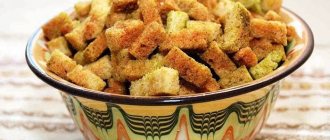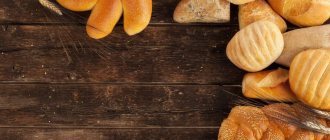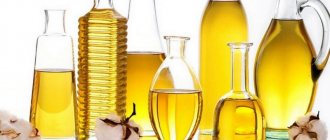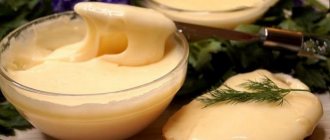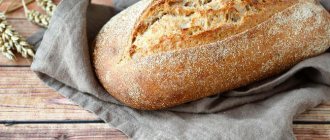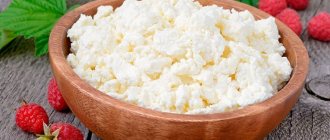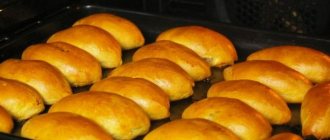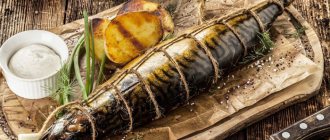Calorie table for bread per 100 grams
The most high-calorie bread is white bread.
The calorie content of almost all types of bread is approximately the same:
| Type of bread | Kcal per 100 grams |
| Wheat | 242 |
| Wheat-rye | 222 |
| With bran | 227 |
| Borodinsky | 208 |
| Rye molded | 217 |
| Whole grain rye | 198 |
| Rye | 165 |
How to calculate the calorie content of 1 piece of bread
On average, the thickness of a piece of bread reaches 0.5 cm, and its weight reaches 40 grams. A piece of black bread weighs approximately 35 grams, a loaf weighs 20 grams, and white bread weighs 25 grams.
To find out how many calories are in bread. You need to know the approximate weight of a whole loaf. From it you need to cut a slice of the usual size. Next, visually divide the entire loaf into the same slices and count their number. Next, you need to divide the total weight of the loaf by the number of resulting slices, determining the calorie content of one piece.
Energy value
The energy value of a product directly depends on its variety. The amount of protein in bread determines the nutritional value of the flour used in preparation. Bread made from wallpaper flour and whole grains has the greatest protein value.
B vitamins and mineral salts can be found in such bread. By consuming this and other types of bread, the body will receive large quantities of sodium, iron, potassium, iodine and other mineral elements.
Rye bread:
- Proteins 8.5 g.
- Carbohydrates 48.3 g.
- Fat 3.3 g.
- Fiber 5.8 g.
- Sodium 660 mg.
- Potassium 166 mg.
- Vitamins of group A, B, E, H, as well as PP.
White bread:
- Fat 3.2 g.
- Carbohydrates 50.8 g.
- Proteins 7.6 g.
- Fiber 2.4 g.
- Sodium 681 mg.
- Potassium 100 mg.
- Calcium 16%.
- Iron 20%.
Wheat bread:
- Proteins 8.7 g.
- Carbohydrates 49.5 g.
- Fat 3.9 g.
- Fiber 5.5 mg.
- Sodium 538 mg.
- Potassium 177 mg.
Black bread:
- Proteins 1.72 mg g
- Carbohydrates 11.29 g
- Fat 0.31 g
- Fiber 2.8 mg g
- Sodium 49 mg
- Potassium 74 mg
Calorie content Bran bread. Chemical composition and nutritional value.
Nutritional value and chemical composition of “Bran bread”.
The table shows the nutritional content (calories, proteins, fats, carbohydrates, vitamins and minerals) per 100 grams of edible portion.
| Nutrient | Quantity | Norm** | % of the norm in 100 g | % of the norm in 100 kcal | 100% normal |
| Calorie content | 239 kcal | 1684 kcal | 14.2% | 5.9% | 705 g |
| Squirrels | 8 g | 76 g | 10.5% | 4.4% | 950 g |
| Fats | 3 g | 56 g | 5.4% | 2.3% | 1867 |
| Carbohydrates | 45 g | 219 g | 20.5% | 8.6% | 487 g |
| Alimentary fiber | 4 g | 20 g | 20% | 8.4% | 500 g |
| Water | 37.8 g | 2273 g | 1.7% | 0.7% | 6013 g |
| Ash | 2.2 g | ~ | |||
| Vitamins | |||||
| Lutein + Zeaxanthin | 54 mcg | ~ | |||
| Vitamin B1, thiamine | 0.397 mg | 1.5 mg | 26.5% | 11.1% | 378 g |
| Vitamin B2, riboflavin | 0.287 mg | 1.8 mg | 15.9% | 6.7% | 627 g |
| Vitamin B4, choline | 18.7 mg | 500 mg | 3.7% | 1.5% | 2674 g |
| Vitamin B5, pantothenic | 0.536 mg | 5 mg | 10.7% | 4.5% | 933 g |
| Vitamin B6, pyridoxine | 0.176 mg | 2 mg | 8.8% | 3.7% | 1136 g |
| Vitamin B9, folates | 161 mcg | 400 mcg | 40.3% | 16.9% | 248 g |
| Vitamin E, alpha tocopherol, TE | 0.32 mg | 15 mg | 2.1% | 0.9% | 4688 g |
| Vitamin K, phylloquinone | 1.3 mcg | 120 mcg | 1.1% | 0.5% | 9231 g |
| Vitamin RR, NE | 4.402 mg | 20 mg | 22% | 9.2% | 454 g |
| Macronutrients | |||||
| Potassium, K | 227 mg | 2500 mg | 9.1% | 3.8% | 1101 g |
| Calcium, Ca | 74 mg | 1000 mg | 7.4% | 3.1% | 1351 g |
| Magnesium, Mg | 81 mg | 400 mg | 20.3% | 8.5% | 494 g |
| Sodium, Na | 486 mg | 1300 mg | 37.4% | 15.6% | 267 g |
| Phosphorus, P | 185 mg | 800 mg | 23.1% | 9.7% | 432 g |
| Microelements | |||||
| Iron, Fe | 3.07 mg | 18 mg | 17.1% | 7.2% | 586 g |
| Manganese, Mn | 1.668 mg | 2 mg | 83.4% | 34.9% | 120 g |
| Copper, Cu | 221 mcg | 1000 mcg | 22.1% | 9.2% | 452 g |
| Selenium, Se | 31 mcg | 55 mcg | 56.4% | 23.6% | 177 g |
| Zinc, Zn | 1.35 mg | 12 mg | 11.3% | 4.7% | 889 g |
| Digestible carbohydrates | |||||
| Starch and dextrins | 38 g | ~ | |||
| Mono- and disaccharides (sugars) | 3 g | max 100 g | |||
| Essential amino acids | |||||
| Arginine* | 0.357 g | ~ | |||
| Valin | 0.385 g | ~ | |||
| Histidine* | 0.196 g | ~ | |||
| Isoleucine | 0.332 g | ~ | |||
| Leucine | 0.603 g | ~ | |||
| Lysine | 0.235 g | ~ | |||
| Methionine | 0.152 g | ~ | |||
| Threonine | 0.256 g | ~ | |||
| Tryptophan | 0.111 g | ~ | |||
| Phenylalanine | 0.419 g | ~ | |||
| Nonessential amino acids | |||||
| Alanin | 0.311 g | ~ | |||
| Aspartic acid | 0.433 g | ~ | |||
| Glycine | 0.334 g | ~ | |||
| Glutamic acid | 2.75 g | ~ | |||
| Proline | 0.918 g | ~ | |||
| Serin | 0.419 g | ~ | |||
| Tyrosine | 0.252 g | ~ | |||
| Cysteine | 0.191 g | ~ | |||
| Saturated fatty acids | |||||
| Saturated fatty acids | 0.8 g | max 18.7 g | |||
| 14:0 Miristinovaya | 0.014 g | ~ | |||
| 16:0 Palmitinaya | 0.438 g | ~ | |||
| 18:0 Stearic | 0.326 g | ~ | |||
| Monounsaturated fatty acids | 1.618 g | min 16.8 g | 9.6% | 4% | |
| 16:1 Palmitoleic | 0.009 g | ~ | |||
| 18:1 Oleic (omega-9) | 1.608 g | ~ | |||
| Polyunsaturated fatty acids | 0.649 g | from 11.2 to 20.6 g | 5.8% | 2.4% | |
| 18:2 Linolevaya | 0.614 g | ~ | |||
| 18:3 Linolenic | 0.035 g | ~ | |||
| Omega-6 fatty acids | 0.6 g | from 4.7 to 16.8 g | 12.8% | 5.4% |
The energy value of bran bread is 239 kcal.
Primary Source: Created in the application by the user. Read more.
** This table shows the average levels of vitamins and minerals for an adult. If you want to know the norms taking into account your gender, age and other factors, then use the “My Healthy Diet” application.
What kind of bread can be used on a diet?
Bread that allows you to avoid gaining weight while losing weight includes the following types:
- Wholegrain – usually baked from coarse white flour. It, in turn, is extracted from unrefined sprouted grains. All this allows you to completely preserve vitamins and minerals even after processing. Whole grain bread contains complex carbohydrates that are not stored in fat stores.
Energy value and calorie content of whole grain bread - Rye. It is distinguished by its content of lysine, an essential amino acid that normalizes almost all vital processes occurring in the body. The sour taste of bread makes baked goods less harmful than regular white ones. Yeast is not added to the dough, but the batch is prepared from sourdough with rye flour and water.
- Buckwheat. It is made from buckwheat flour and has the lowest calorie content among other varieties. It contains much more carbohydrates compared to bran bread. The advantage of buckwheat bread is the large complex of vitamins and minerals it receives from buckwheat.
- With bran . One of the most suitable options for diet. It normalizes digestion, promoting the complete removal of waste and toxins. Bread contains large quantities of nicotinic acid, vitamins, fiber, and protein.
Benefits for weight loss
Bran bread, the harms and benefits of which we are discussing today, is a healthy dietary baked product. Many people think that on a diet they should completely abstain from eating flour products. Of course, it’s worth quickly walking past the shelves in the store with aromatic loaves, pastries, cakes, rolls and crispy French baguettes. But it is recommended to linger near the shelf where the bran bread is.
White bread or a loaf contains simple carbohydrates, which do nothing but harm our figure. Another thing is bran bread. It contains complex carbohydrates that will not be stored in problem areas. They are processed by the body for a very long time, eventually turning into useful energy. Consequently, bread with bran is not only not harmful to the figure, but even promotes rapid fat burning.
How many calories are in bread crumbs?
Bread crumbs contain many vitamins and nutrients: phosphorus, potassium, iron, magnesium and sodium. The calorie content of the product is high and reaches 392 Kcal per 100 grams.
Crackers from a loaf in 100 grams of product contains 1.4 g of fat, 11.2 g of protein, 72.7 g of carbohydrates and 331 kcal. Rusks are useful due to the presence of vitamins E, B1 and B2, and PP in their composition. Minerals include phosphorus, iron, potassium, magnesium, copper and calcium.
In breadcrumbs, the calorie content reaches 395 Kcal. The breading itself is usually added a little, but it adds overall energy value. If these are breadcrumbs made from black bread, then 100 g of the product will contain 210 calories, 0.7 g of fat, 49.8 g of carbohydrates and 4.7 g of protein.
Is bread good for the body?
The beneficial properties of the product for the human body are as follows:
- improves intestinal function due to the presence of fiber and dietary fiber;
- gives a feeling of fullness for a long time;
- whole grain variety normalizes work processes in the cardiovascular system;
- has a large amount of minerals that help strengthen the body;
- most varieties contain microelements: silicon, zinc, copper and vitamins of groups F, A, E;
- bread contains amino acids and protein, which are essential for increasing muscle mass;
- protects against stress thanks to vitamin B, which has a positive effect on the nervous system.
Useful properties of the product
Low fiber intake causes most of the digestive tract problems in modern people. Refined food products, which are completely purified from natural fibers, contribute to the disruption of the proper functioning of all body systems. To solve this problem, food today needs to be enriched with special grain husks in granular form; you can also eat bread with bran. The benefits of this product are quite obvious. Dietary fiber, which is part of bran baked goods, helps regulate the functioning of the gastrointestinal tract, eliminates and prevents constipation, promotes the elimination of cholesterol and toxins, prevents the occurrence of atherosclerosis, increases hemoglobin in the blood and qualitatively improves its composition.
Content:
- Useful properties of the product
- Effect of the product on weight loss
- Who should not use the product
- Home cooking
- Diet bread according to Dukan
Unrefined fiber lowers the glycemic index of baked goods. This product is great for weight loss, improves the absorption of nutrients from food, and helps cleanse the walls of the digestive organs. Grain fiber is very useful for iron deficiency; it, being a natural adsorbent, solves many problems with skin, hair, fungal diseases and allergies. The disadvantage of bran bread is its specific taste, shape and consistency of the finished product.
The beneficial effects of the product on the human body depend on the proportions of bran in the recipe. The most valuable are baked goods, to which about 20 percent of grain husks are added. However, abuse of such a product can lead to side effects and negative consequences. An adult should not consume more than 30 grams of dry grain shells per day, but it is almost impossible to determine their amount in ready-made store-bought bread. Therefore, if you already eat bread with bran, then no more than 300 grams per day in the morning. If you experience discomfort in the gastrointestinal tract, you should stop baking until the symptoms completely disappear, and then start consuming it in smaller quantities.
The most useful bread with bran is divided into several subtypes, depending on the effect on human health and the methods of its preparation.
He can be:
- Whole grain, which is necessary for diabetes, high cholesterol, excess weight and diseases of the cardiovascular system.
- Live, which is prepared using starters based on sprouts and whole wheat grains. Living bread with bran is useful for vitamin deficiency and excess weight.
- Biobread made exclusively from ingredients of natural origin - seeds, nuts, different types of flour, vegetables (carrots, celery, pumpkin, tomatoes).
- Bread made by removing moisture from bran bread. This is a light and tasty product, but there is a risk of purchasing low-quality products in which the manufacturer has added flavor enhancers and other artificial substances.
The store range of bran bread is quite wide; it is important to choose exactly the product that will be useful for a particular organism. If you can’t find one ready-made, you can easily bake it at home.
Which bread is harmful to the body?
The most dangerous loaf for the body is made from refined wheat flour.
After factory processing, it is completely deprived of all beneficial properties and retains dangerous components for a long time, such as potassium bromate, quickly digestible carbohydrates, benzoyl peroxide, chlorine dioxide, alloxan and ammonium persulfate.
This provokes excess weight gain, weakens the body’s defenses, worsens overall health, and reduces immunity. In some cases, the situation can lead to the occurrence of oncology, limited intake of fatty acids and tocopherol, which are vital for the body, the entry of carcinogens into the body, and the deactivation of many enzymes.
Is it possible to have bread on a diet?
You shouldn’t give up bread while on a diet. It is better to choose the right type of bread and control how many calories are in the bread you eat. When dieting, experts advise avoiding flour products made from butter dough, high-quality wheat flour and those products that contain sweet filling or baking powder.
When purchasing, you should pay attention to the composition, compare different varieties based on energy value and choose the most suitable one. The best option is dietary bread, which includes bran or grain varieties.
It contains a minimal amount of sugar, complete absence of baking powder and wheat flour. It’s good if the chosen bread contains raisins, nuts, whole grains or sprouted grains.
How to bake bread with bran?
The healthiest version of such bread, of course, will be homemade - it is easy to control the beneficial and harmful components in it. There are a lot of recipes in open sources, you can always find the most successful one just for you, or simply replace part of the flour in any of them with bran. However, there are a few things to keep in mind when choosing a recipe:
- Try to ensure that the amount of premium flour does not exceed 50%, and it is better when the recipe excludes it completely.
- Refrain from yeast bread - the one with sourdough is much healthier.
- Dark bread options are always healthier than wheat breads because they are gluten-free.
Bakery product ideas for losing weight
Oat bran bread
Compound:
- oat bran – 20 g.
- eggs – 3 pcs.
- olive oil – 8 g.
- spices.
- kefir (1%) – 70 ml.
- sesame.
- rye flour – 150 g.
Preparation:
- First, mix the available products until smooth.
- By wetting your hands in water from time to time, you need to create a suitable shape.
- Next, you need to bake the product in the oven at 180 °C for 40 minutes.
Rye bread with kefir
Ingredients:
- kefir (1%) – 200 g;
- eggs – 2 pcs.;
- rye flour – 225 g;
- olive oil – 1 tsp;
- salt;
- baking powder.
Preparation:
- It is necessary to thoroughly beat the eggs and dilute with olive oil. Add flour, kefir.
- Add a pinch of salt and baking powder. Mix everything and get a homogeneous mass.
- Next you need to preheat the oven to 180°C. Let the dough rest for 40 minutes.
Homemade bread with dried fruits and nuts
Ingredients:
- kefir – 300 g.
- salt – 0.5 tsp.
- soda – 0.5 tsp.
- whole grain flour – 330 g.
- walnuts.
- prunes.
How to cook:
- It is necessary to mix soda and kefir. Leave the resulting mixture for 30 minutes.
- Next you need to add nuts, prunes
- While stirring the liquid, gradually add flour until the dough is completely formed.
- Place in a mold and place in an oven preheated to 180°C for fifty minutes.
Types of baked goods with bran
Bran can be purchased separately and used independently by adding to various homemade baked goods. With bran you can make muffins, buns, loaves, pancakes, pancakes, bread, and cookies. Doctor's bread with bran and protein bread is very popular among adherents of a healthy diet. Doctor's bread is considered one of the healthiest types of baked goods. It is baked in accordance with GOST. No yeast is used in its preparation.
Protein contains a significant amount of vegetable protein and fiber. Recommended for those who want to reduce the amount of carbohydrates in their diet.
How to eat baked goods while on a diet
An important rule of the diet is to eat foods with carbohydrates for breakfast and proteins for dinner.
Bread should be eaten in the first half of the day. This allows the body to process the received substances into energy, rather than storing them to form fat cells.
You should not combine bread with sausage and mayonnaise. It is healthier to eat sandwiches with fish and cheese. Dietary bread is combined with soup or vegetables. Oils, meat products, and cereals contain a huge amount of carbohydrates, so combining them with bread is not recommended.
Harm
This is not to say that a bran product is harmless. The product may contain rough and sharp particles of husk that can damage the gastrointestinal tract. For this reason, bread is not recommended for those who suffer from:
- Peptic ulcer disease.
- Gastritis.
- Colitis.
- Pancreatitis.
- Hemorrhoids.
- Diarrhea.
- Overactive colon.
- Irritable bowel syndrome.
Those who are obese should eat bread in small quantities (1-2 small pieces per day and preferably before 12:00 ). Of course, it promotes weight loss, but its calorie content is not that low, so the product may cause additional weight gain.
How to replace baked goods
Salad
Lettuce leaves can be an excellent substitute for dietary bread. They are usually used as the basis for a sandwich, which in the end turns out not only very tasty, but also healthy for the body.
Meat and cheese go well with lettuce. For extra enjoyment, you may want to consider adding sauce.
Bread
Another alternative to bread is bread. They are made from coarsely ground grains. In terms of calorie content, they differ little from ordinary bread, but their quality is immediately visible. In addition, the bread contains a lot of fiber. Like lettuce, they are used as a base for a sandwich or as a snack on their own.
Biscuits
Such products usually take the form of cookies or flatbreads. They contain water and barley or pea or bean flour. Biscuits can be stored for a long time, fully retaining their taste and beneficial qualities.
Pita
Lavash can be a very convenient and tasty substitute for regular bread. After all, it is prepared extremely easily from three “harmless” products - salt, flour and water. There are no flavorings, no raising agents, no flavoring additives, or even yeast. This is an ideal option for dietary nutrition. For example, you can put chicken, cheese or vegetables in the finished pita bread.
Knowing how many calories are in bread, you can determine which type of product is best suited for a particular diet. The main thing is not to completely give up bread, but to approach this issue wisely. This product saturates the body with useful substances every day, thereby being a source of good mood and vitality.
You should eat no more than 150 grams per day. bread, then he will not break even a strict diet.
While on a diet, there is no need to completely limit the consumption of bread in your daily low-calorie diet. In order not to give up the product, you need to know how many calories are in different types of bread and how to use it in a limited menu diet for weight loss. The main thing is to lose weight correctly and always stay healthy!
Article design: Vladimir the Great
